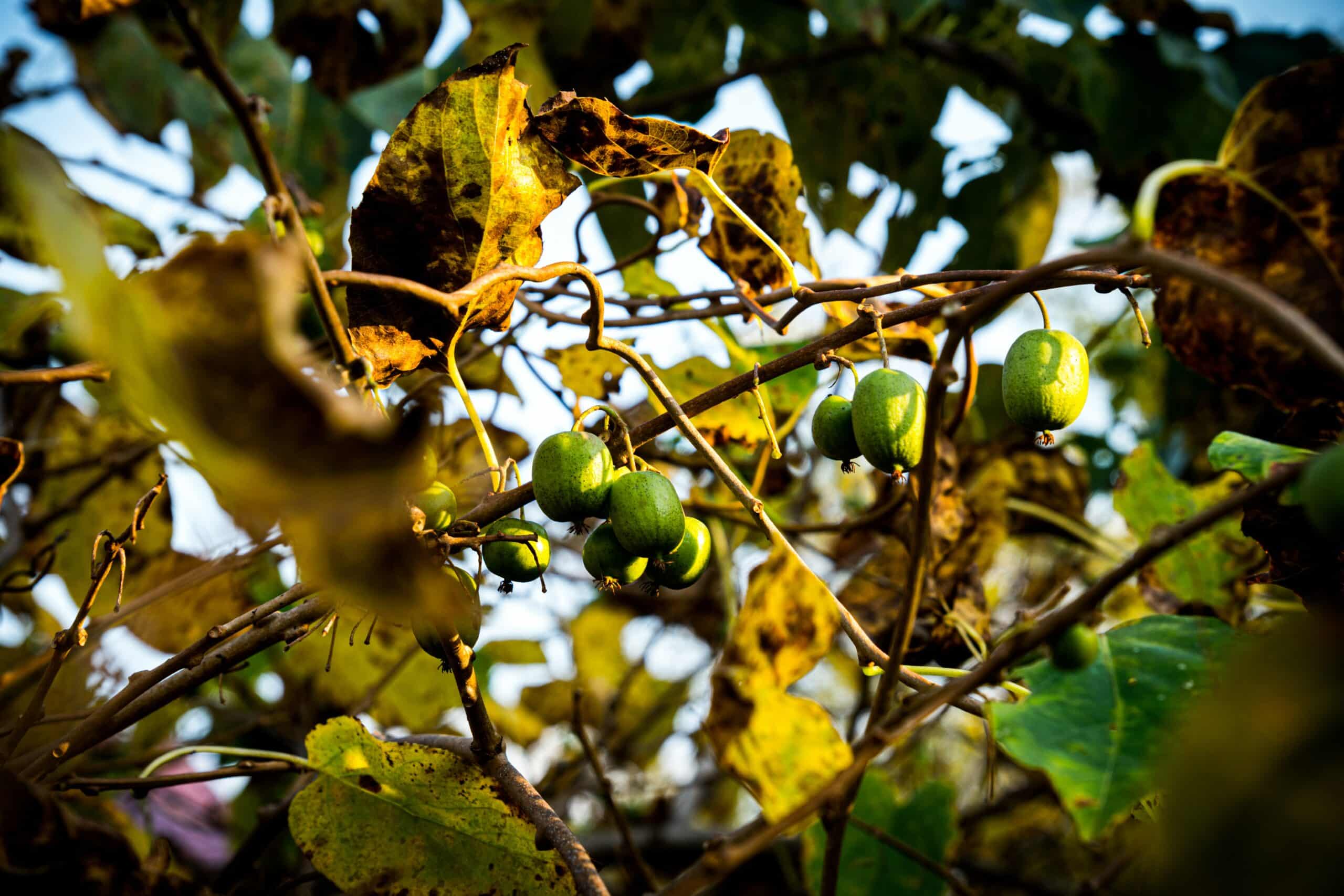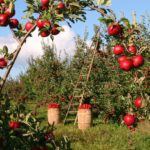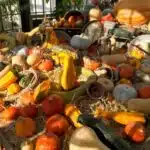Have you ever wondered what it would be like to have a kiwifruit vine growing in your garden? For anyone with even the slightest bit of botanical know-how, the idea of cultivating a kiwifruit vine might seem like an impossible dream. After all, these are delicate and intricate plants that require a great deal of care and attention. But don’t despair! With some simple tips on how to properly plant and care for a kiwifruit vine, you can turn your green thumb into a thriving and productive garden.
The kiwifruit is a unique species of fruit that is native to New Zealand. It has become increasingly popular in recent years due to its sweet taste, high nutritional value, and attractive appearance. As such, many people are now interested in growing their own kiwifruit vines for both personal consumption and commercial production. Fortunately, with the right knowledge and techniques, it is relatively easy to cultivate a successful crop of kiwifruits in your own backyard or small plot of land.
In this article, we will provide an overview of the basics of planting and caring for kiwifruit vines. We will discuss the different types available, as well as which ones are best suited to particular climates and regions. We will also provide tips on how to properly water and fertilize your vines, as well as how often they should be pruned for optimal growth. Finally, we will discuss potential pests or diseases that may affect your vines so that you can take steps to prevent them from ruining your crop. So read on if you’re ready to learn about how to grow delicious kiwifruits in your own backyard!
What Is A Kiwifruit?
Kiwifruit, also known as Chinese gooseberry, is a woody, perennial vine with edible fruit. Native to the Chang Kiang Valley of Northern China, kiwifruit has become an increasingly popular crop worldwide due to its unique flavor and health benefits. Despite being a relatively low-maintenance plant, there are certain aspects of kiwifruit growth and care that must be taken into consideration in order for the vines to thrive.
First and foremost, soil pH should be tested before planting or establishing new kiwi vines. While soil pH can be adjusted depending on the desired range, it is best to seek out well-draining soils that are slightly acidic with a pH between 5.0 and 6.5 for optimal growth. If planting in pots or containers, use a potting mix that drains well and contains organic matter such as compost or peat moss for added nutrients.
When it comes to selecting a variety of kiwi, there are numerous cultivars to choose from including Hayward, Bruno and Monty – each boasting different flavors and hardiness zones. The ideal choice will depend on your climate zone as some varieties are better suited for warmer climates while others can tolerate colder temperatures; further research is recommended when deciding which variety would work best in your area.
Selecting A Kiwi Variety
When selecting a kiwi variety, there are several factors to consider. The most important is the climate where you will be growing your vines. Different varieties of kiwi require different temperatures and conditions in order to thrive. Additionally, the size and shape of your desired fruit should be taken into account. Some varieties produce larger fruits than others, while some have a more oval or oblong shape than others.
The next factor to consider when selecting a kiwi variety is pollination needs. Most varieties of kiwi are dioecious, meaning that male and female plants must be planted together for successful pollination and fruiting. Make sure to select a compatible pair of male and female plants for optimal results.
Finally, it’s important to think about the flavor of the fruit you want to grow. Different varieties offer unique flavors ranging from tart and tangy to sweet and juicy, so make sure you choose one that fits your taste preferences best! With these considerations in mind, we can now move on to discussing location, soil and sun requirements for successful kiwifruit growth.
Location, Soil And Sun Requirements
Choosing the right location for a kiwi vine is critical for success in growing this fruit-bearing plant. Consider it an investment of time and energy, because the rewards can be bountiful. I recently had a client who wanted to grow kiwi on her property. With careful selection of the right spot and attentive care, she achieved a wonderful harvest of this delicious fruit!
The location you select should have plenty of sun – at least six hours daily – as well as good drainage and soil that’s deep and rich in nutrients. If possible, find a spot that’s sheltered from strong winds, which can damage vines easily. Kiwis also benefit from some kind of support structure such as an arbor or trellis to help them climb upwards and make harvesting easier.
Finally, consider how close the vines will be to other plants or structures like buildings or fences. The roots may spread out two meters or more so it’s important to give them enough space to grow without coming too close to other objects that might put them at risk for disease or injury. By selecting the best site for your kiwi vines and following these tips, you’ll be well on your way to enjoying a successful harvest!
Planting And Care
Now that we’ve discussed location, soil, and sun requirements for growing kiwifruit vines, let’s move on to planting and care. Planting kiwi vines is an easy process, provided the area is prepared properly. The first step is to ensure the soil has been adequately fertilized and mulched. This is especially important if you’re planting in an area with sandy or clay soils. You’ll also want to make sure there are ample drainage holes in the ground for excess water to escape.
Once the soil is ready, you can begin adding your kiwi vines. It’s best to plant them at least two feet apart from each other so they have adequate space to spread out. When planting the kiwi vine, make sure its roots are fully covered by the soil and gently press down on it after you place it in the ground. This helps ensure good contact between the root system and the soil.
Finally, you’ll want to keep up with regular maintenance of your kiwi vines by providing adequate water throughout their growth season and pruning them back as needed during late winter or early spring. This will help promote healthy growth and help keep pests away from your plants. With proper care, you can enjoy a thriving harvest of delicious kiwifruit for years to come!
Fertilizing Kiwifruit
In the world of gardening, there are certain tasks that must be done in order to ensure a successful crop. Fertilizing is one such task – and when it comes to kiwifruit, fertilizer is particularly important! But what exactly does fertilizing kiwifruit involve? Let’s find out.
Fertilizing kiwifruit requires an understanding of the plant’s needs and the right methods for providing those needs. For example, you’ll need to know which nutrients the plant needs, how much they need, and when they should be applied. Here are some tips on fertilizing your kiwi vines:
•tNutrients: The two main nutrients that kiwifruits need are nitrogen and potassium. Applying a balanced fertilizer every two months will provide adequate amounts of these essential nutrients for healthy growth.
•tAmounts: It’s important to apply the right amount of fertilizer for your particular soil type. Usually 2-3 pounds per 100 square feet is sufficient. If in doubt, check with your local nursery or extension office for advice on how much to use in your specific location.
•tTiming: The best time to fertilize your kiwis is late spring or early summer when new growth is beginning to appear. This will give the plants a burst of energy and help them reach their full potential during the growing season.
Fertilizing correctly will help ensure that your kiwi vines produce abundant fruits come harvest time! By following these simple steps you can make sure your plants get all the nutrition they need for optimal health and productivity – so don’t forget about this critical step as you plan out your gardening routine this year!
Pruning Kiwifruit Vines
Pruning kiwifruit vines is an important part of proper plant care. The aim is to produce the best possible yield and quality of fruit while keeping the vine in shape. Pruning should be done at least twice a year, once in late winter and again in summer.
It’s important to know the right pruning techniques and timing for your particular variety of kiwi vine. Generally, you’ll want to remove any dead or diseased vines, as well as any weak or unproductive growth. You may also want to limit the overall size of the vine by removing some of the older growth each year.
To ensure your kiwifruit vine remains healthy and productive for years to come, it’s important to keep up with regular pruning and maintenance. By doing so, you’ll be able to maximize yields and encourage the development of strong new growth that can bear fruit for many seasons ahead. With careful pruning practices, you can help ensure your kiwifruit vines remain healthy and productive for years to come.
Now that we’ve discussed how to properly prune kiwifruit vines, let’s move on to controlling pests and diseases that can cause damage or reduce yields if left unchecked.
Controlling Pests And Diseases
Controlling pests and diseases is essential to growing healthy kiwifruit vines. As a specialist in botany and gardening, I know that there are various factors which can affect the health of a kiwifruit vine. These include exposure to weather conditions, natural predators, and even human interference. The best way to protect your kiwifruit vine from pests and diseases is through prevention.
A few important steps you can take for prevention are: regularly inspect your plant for signs of disease or damage; use an organic pesticide if you find any unwanted insects on your vines; keep the area around your vine free from debris; and make sure that all weeds are removed as they can attract pests or spread diseases. Additionally, it’s important to provide adequate air circulation around your vines. This helps prevent fungus growth which could otherwise cause serious damage to your plant.
Finally, it’s important to stay vigilant in controlling pests and diseases around your kiwifruit vine. If these issues arise, you should take action immediately in order to minimize any potential damage that could occur. With proper care and attention, your kiwifruit vines will remain healthy for many years to come! With that said, let’s move on to training kiwifruit vines for optimal harvest.
Training Kiwifruit Vines
Training kiwifruit vines is an important step in the growth and health of the plant. This can be done through the use of trellis systems, which help to support the weight of the vine and assist in controlling its shape. It’s also essential for productivity and harvest, as training can give you a better understanding of where you need to prune for maximum yield.
When training a kiwifruit vine, there are certain methods that should be followed. The main aim is to create an even canopy with a single leader stem, by tying individual shoots to their respective supports. You should also keep an eye out for any crossing over or rubbing branches – if not addressed quickly this can cause significant damage to the vine. Finally, it’s important to regularly inspect the vines throughout their growth cycle, making sure they are securely tied in place and that no damage has occurred due to weather elements or pests.
Depending on your location and climate conditions, you may find it beneficial to prune back some of your kiwifruit vines during winter months when they’re dormant – this will encourage them to grow more vigorously come springtime. Pruning should always be done carefully and judiciously however; too much cutting can lead to weakened vines that might be more susceptible to disease or insect attack.
TIP: Remember, when training your kiwifruit vines it’s important not only for proper shape but also for maximum yield – so take your time and do it right!
Propagating Kiwifruit
Some may think propagating kiwifruit is too difficult or time consuming, but it’s actually quite easy and rewarding. In fact, with a little bit of effort, you can grow your own kiwifruit vines from scratch! As a specialist in botany and gardening, I’m here to help make the process as simple and successful as possible.
To begin propagating kiwifruit, you’ll need to start with some healthy vines. Once you have your vines, select a few branches from the vine and cut them off at a 45-degree angle. Strip away any leaves at the base of the cutting to expose one-half inch of stem. Dip the base of the cutting into rooting hormone powder, which will help encourage root growth when planted in soil.
Next, fill containers with high-quality potting soil that drains well and place cuttings in each container so that they are six inches apart from each other. Make sure to water them generously after planting. Place the containers in an area that receives bright indirect light for several hours per day. Keep an eye on the soil moisture levels by checking twice daily; if it starts to dry out then give it more water until roots form and new growth begins appearing on top of the soil.
With these steps done correctly, you’ll be on your way to having some beautiful kiwi fruit vines! Now let’s get started learning how to provide winter care for your new kiwifruit plants...
Winter Care For Kiwifruit
Winter is an important season for kiwifruit. During this period, special care should be taken to ensure that the plants remain healthy and vigorous. Firstly, it is essential to protect the plants from freezing temperatures by layering them with mulch or straw. This provides insulation during cold winter nights, trapping heat inside the soil and helping to protect the roots against frost damage. In addition, any existing vines should be pruned drastically in order to promote a strong and healthy structure for next season’s fruiting potential. Secondly, water should be provided on a regular basis throughout the winter months in order to prevent dehydration of the plant. A watering regime of once every two weeks is generally sufficient during mild winters, while more frequent irrigation may be necessary in regions that experience colder weather conditions. Finally, fertilization can also play an important role in maintaining kiwifruit health during wintertime. Light applications of a balanced fertilizer can help promote vigor and resilience within the vine without causing excessive growth that may lead to other problems later on. With these simple steps, you can ensure your kiwifruit will have all they need for a successful growing season ahead!
Harvesting Kiwifruit
It’s time to harvest your kiwifruit! As the bounty of the season begins to come in, you’ll be rewarded for all your hard work. You can enjoy the fruits of your labor with a few simple steps. Here’s what you need to know about harvesting kiwifruit:
Timing is everything – You should start to harvest kiwifruit when they turn a dark green or brown color and feel slightly soft when squeezed gently. Ripe fruit will also have a sweet aroma that fills the air around it. If you wait too long, the fruit will become too soft and may not store well.
Consider the weather – If it’s been raining heavily or if there is an abundance of dew on the ground, it’s best to wait until the next day before harvesting as this can make the fruit more prone to rotting.
Use proper tools – Make sure you are using clean, sharp clippers or scissors when cutting off fruit from its vine, so as not to damage both plant and fruit alike. Once harvested, place each piece of fruit in a clean basket or container for transport back home.
With these steps in mind, you’re ready to reap what you’ve sown! Now that we’ve gone over harvesting kiwifruit, let’s move on to how to store and preserve them for future use.
Storing And Preserving Kiwifruit
Once the kiwifruit are harvested, it’s important to store and preserve them properly. The best way to store kiwifruits is by keeping them in a cool, dry place. This will help keep them fresh and prevent them from spoiling. It’s also important to keep the kiwifruits away from direct sunlight or heat sources as this can cause ripening too quickly.
When storing kiwifruits, it’s a good idea to separate any that are overripe so they don’t spoil the rest of your harvest. If you need to store large amounts of the fruit for an extended period of time, you may want to consider preserving them. Drying or freezing the fruit are both great options for preserving kiwifruit.
When drying out the fruits, make sure to slice them into thin discs so that they can dry more evenly. You’ll then want to spread the slices out on a paper towel and let them sit until they’re completely dried out before storing in an airtight container. For freezing, simply wash off any dirt or debris and core out any seeds before placing in a freezer-safe bag and storing in your freezer for up to 6 months.
TIP: To ensure maximum shelf life for your preserved kiwifruit, make sure that all containers are properly sealed when stored at room temperature or below 40°F (4°C).
Using Kiwifruit In The Kitchen
Kiwifruit is a symbol of life, with its fuzzy golden-brown skin and sweet green flesh. As an edible delicacy, kiwifruit offers a unique flavor and texture that can be used to enhance recipes from appetizers to desserts. For those who are interested in exploring the culinary possibilities of this delightful fruit, here is a guide for using kiwifruit in the kitchen.
When preparing kiwifruit, begin by washing it thoroughly with cold water. The skin can then be peeled with a paring knife or vegetable peeler, although you may also choose to leave it on if desired. Next, slice the fruit crosswise into thin discs or cubes. The seeds can remain in place when eating the raw fruit, or they may be scooped out with a spoon if desired.
Kiwifruit can be eaten raw as part of a fruit salad or smoothie, added to yogurt or oatmeal, or tossed with fresh greens for a flavorful salad topping. It pairs well with other fruits such as apples and berries and makes an interesting addition to savory dishes like stir-fries and pasta salads. Baked goods such as pies and muffins also benefit from the addition of kiwi slices or puree. When cooked into jams or jellies, it produces a vibrant green hue that adds visual interest to your pantry offerings.
From its versatility in recipes to its pleasing texture and flavor profile, there’s no denying the deliciousness of kiwifruit in your culinary creations! With just a little bit of practice and experimentation, it’s easy to incorporate this amazing fruit into your favorite dishes.
Common Questions About Growing Kiwifruit
When it comes to growing kiwifruit, there is a lot of curiosity and enthusiasm amongst gardeners and botanists. With its lush foliage and delicious fruit, this vine-like plant can be grown in many climates. In this section, we are going to answer some of the common questions about growing kiwifruit:
Is kiwifruit difficult to grow? No, kiwifruit is not difficult to grow as long as you provide it with the right conditions. It prefers well-drained soil with plenty of organic matter and full sun exposure. Water regularly during dry spells and prune vines periodically for a strong, healthy structure.
How do I harvest my kiwifruits? Harvesting your kiwifruits is easy – just wait until the fruits turn brownish green or bronze in color before picking them off the vine. Make sure you use sharp scissors or pruning shears so you don’t damage the plant or fruit.
What kinds of pests should I be aware of when growing kiwifruit? A few pests may be attracted to your kiwifruit plants such as aphids, mealybugs, scale insects, and whiteflies. To combat these pests, it’s important to keep your plants clean by removing dead leaves or stems and spraying them with insecticidal soap or neem oil if necessary.
Can I grow different varieties of kiwifruit together? Yes! You can mix different varieties of kiwifruits together for a more varied harvest each year. Just make sure that you give each variety enough space on the trellis and provide adequate support for their vines since different varieties will have varying growth habits.
How long does it take for my kiwi fruits to ripen? The amount of time it takes for your fruits to ripen will depend on the variety but generally speaking, most types will ripen between three to four months after flowering has finished. If you want an earlier harvest, try planting early-season varieties such as ‘Hort16A’ or ‘Hayward.
With careful attention and proper care, anyone can successfully grow delicious fruit from their own home garden! Now let’s look at troubleshooting some common problems that may arise while caring for your kiwi vines…
Troubleshooting Common Kiwifruit Problems
Growing kiwifruit can be a rewarding and satisfying experience. However, as with all plants, there may be instances when they do not perform as expected. To troubleshoot common kiwifruit problems, it is important to know what to look for and how to remedy the situation. A few years ago, I was growing kiwifruit vines in my garden and ran into some issues with the fruit production. After doing some research and consulting with more experienced growers, I was able to identify and address the problems that were causing my poor harvest. The most common issue encountered when growing kiwifruit is poor pollination. This can be remedied by increasing the number of pollen-bearing male plants nearby or by hand-pollinating the female flowers using a soft brush. Without good pollination, the vine will produce fewer or smaller fruits. In addition to pollination issues, disease or pests can also affect fruit production. To avoid this problem, growers should keep their vines well-watered and prune them regularly to ensure good air circulation around the plant. Finally, nutrient deficiency can also hinder kiwifruit growth and cause stunted plants or fewer fruits than expected. If you suspect your soil is lacking in nutrients, fertilize it with a balanced fertilizer specifically designed for fruit-bearing plants such as kiwi vines. By taking proactive steps such as these, you should have no problem producing an abundant harvest of sweet and delicious kiwifruits!
Frequently Asked Questions
How Long Does It Take For A Kiwifruit Plant To Bear Fruit?
Kiwifruit plants are a popular fruit-bearing ornamental with attractive foliage, and many gardeners are eager to get them established and producing. But how long does it take for a kiwifruit plant to bear fruit? The answer depends on the variety of kiwi vine and the conditions in which it is grown.
Kiwifruit vines can take up to three years to produce their first fruits but, with good care, they can start bearing much earlier. Depending on the variety, some can bear in as little as one year. Regular pruning helps encourage the production of flowers and fruits at an earlier stage by stimulating new growth.
Fertilizing your kiwi vine properly will also help speed things along. Providing adequate nutrition and water throughout the growing season will boost flower production and fruit set. With proper care, planting multiple varieties that cross-pollinate each other, and pruning correctly, you should be able to enjoy your own homegrown kiwis in no time!
Are Kiwifruit Plants Self-Pollinating?
Growing kiwifruit is an enriching experience for any gardener. Not only does it provide a sweet, healthy snack for the entire family to enjoy, but it also adds beauty to your landscape. But before you can reap the rewards of your harvest, you must first understand if your vines are self-pollinating or not.
Kiwifruit plants are members of the Actinidia genus and are not typically self-pollinators; however, some varieties within this botanical family do possess this trait. The female flowers of these particular plants will produce fruit even without pollination from a male plant–but only under specific circumstances. For example, in order for self-fertilization to occur there must be adequate sunlight and temperatures that fall between 40°F and 95°F (4°C – 35°C). Plus, sufficient airflow and humidity levels in the environment must also be present. Here’s a list of key points to consider when determining if your kiwi vine is self-pollinating:
- Does the variety belong to the Actinidia genus?
- Is there adequate sunlight and temperature?
- Are there sufficient levels of humidity?
- Is there enough air flow around the area?
In order to achieve success with a kiwifruit vine, all these factors must be taken into account when considering whether or not it is capable of being self-pollinated. If any one of them is off balance then you may need to look into other pollination options such as using bees or hand pollination as means for achieving successful fruiting. With proper care and attention, your vine should bear fruit within 4-7 years depending on its growth rate and climate conditions in your area.
How Should Kiwifruit Be Harvested To Ensure Quality?
Harvesting kiwifruit can be likened to a delicate art form; each piece must be handled with the utmost care and precision if you are to ensure its highest quality. As a specialist in botany and gardening, I understand the importance of harvesting kiwi fruit at just the right time. Here’s what you need to know.
Firstly, timing is key when it comes to harvesting kiwifruit. You’ll want to wait until your fruits have reached their full size and color before picking them off the vine. If you harvest too soon, you may end up with smaller, immature fruits that won’t offer the same flavor profile or nutrition. Furthermore, it’s important to check for any signs of damage or mold before harvesting as these will reduce the shelf-life of your fruit significantly.
It’s also essential that you use a sharp knife or scissors when harvesting your kiwis, as this will help prevent any bruising or other damages that can occur during removal from the vine. Finally, it’s important to handle your fruits gently once they’ve been harvested, as rough handling can cause bruising or breakage of the skin which will again reduce their shelf-life and overall quality.
By paying attention to these details when harvesting kiwifruit, you can ensure that they remain at their best throughout their journey from vine to plate – providing an enjoyable experience for everyone who enjoys them!
Are There Any Companion Plants That Can Be Grown With Kiwifruit?
Gardening is an art, and kiwifruit is no exception. To grow these succulent vines, you need to consider the type of companion plants that will enhance their growth. Like a master artist, carefully choosing the right partners can make all the difference for your kiwi crop. Let’s take a look at some of our options – like putting on a palette of colors for a painting.
First off, let’s talk about legumes. These plants are known to be nitrogen fixers, meaning they can help add essential nutrients to the soil around your kiwi vines. This could include clovers, beans, peas and even alfalfa. All of these can help create the perfect environment for your fruit-bearing vines to thrive in.
Next up is cover crops like oats and rye. Both of these are great for providing mulch which helps keep moisture in the soil while also acting as a natural weed repellent. Not only will this help keep pest levels down but it also helps maintain soil fertility which is essential for kiwi growth and harvest quality.
Finally, don’t forget about herbs like basil or oregano which can attract beneficial insects like bees and ladybugs which help pollinate your kiwis! A few well-placed companion plants here and there can make all the difference in how your kiwifruit vine grows, so why not give it a try? Adding some extra support could be just what you need for a successful harvest!
Are There Any Cold-Hardy Varieties Of Kiwifruit?
When it comes to growing kiwifruit, cold hardiness is an important factor to consider. This tropical fruit needs warm climates and frost-free areas to thrive, making it unsuitable for many regions. Fortunately, there are several cold-hardy varieties of kiwifruit available that can withstand cold temperatures.
Kiwifruit vines are usually classified as either A-type or B-type depending on their cold hardiness. A-type varieties are considered more cold hardy than B-types and can survive temperatures down to -10°F (-23°C). These varieties include ‘Ananasnaya’, ‘Hort 16A’, ‘Tomuri’, and ‘Hayward’. On the other hand, B-types such as ‘Issai’ and ‘Chico’ have some cold hardiness but cannot tolerate temperatures below 20°F (-6°C).
Selecting the right variety for your climate is essential for successful kiwifruit production. Gardeners in colder climates should look for A-type varieties that can withstand low temperatures while gardeners in milder climates may be able to get away with a less hardy variety like ‘Issai. No matter which type you choose, make sure you provide adequate protection from extreme weather conditions such as frost or strong winds. With proper care and attention, you can enjoy homegrown kiwi fruits no matter where you live!
Conclusion
Kiwifruit is a delicious and nutritious addition to any garden. With proper care and patience, it can be grown in almost any climate. With the right companion plants, such as blackberries and grapes, kiwifruit trees can thrive in a variety of conditions.
When harvesting kiwifruit, it is important to wait until they are fully ripe before picking them. This will ensure that the fruit is of the highest quality and will be sweet and enjoyable when eaten. Cold-hardy varieties are available for those who live in more northern climates, making the cultivation of this wonderful fruit possible even in areas with cooler temperatures.
For anyone interested in growing their own kiwifruit, there is no better time than now! With a little bit of knowledge and dedication, you will soon have your own delicious batch of kiwi vines to enjoy. So don’t hesitate – get out there and start harvesting your very own kiwis today!









![How To Grow And Care For Corkscrew Vine 12 Strophanthus preussii [Corkscrew Flower, Poison Arrow Vine, Spider Tresses, Tassel Vine] Apocynaceae](https://green-life.blog/wp-content/uploads/2023/04/KW5aFOG5S3jq-150x150.jpg.webp)



















